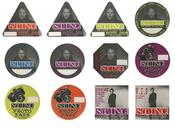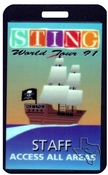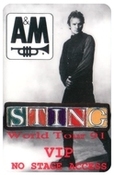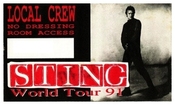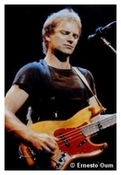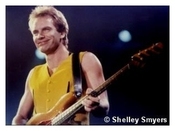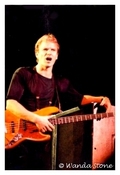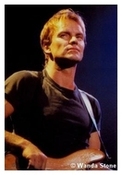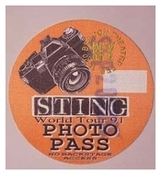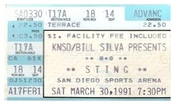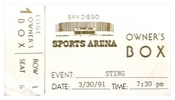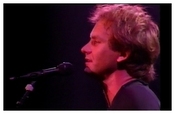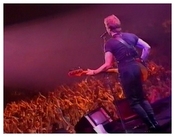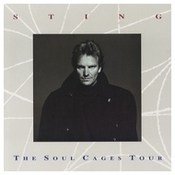
Soul Cages
Mar
30
1991
San Diego, CA, US
San Diego Sports Arenawith Concrete Blonde, Vinx
Were Sting fans solemn or bored?
It's been eight years since Sting came to San Diego with a Police escort.
In that meantime, Sting surrounded himself with a successful solo career that proved he didn't need backup from Policemen Stewart Copeland and Andy Summers. For Saturday night's near-sellout concert at the Sports Arena, Sting proved he didn't need the protection of yellow-jacketed security guards gathered around the stage.
When Sting opened with 'Jeremiah Blues' from his recently released 'Soul Cages' album, polite applause followed. The crowd sat quietly through three more new songs, apparently trying to determine whether Sting had, indeed, taken the stage.
Confirmation came with one word: 'Roxanne'.
That brought the crowd to its feet and put some life into the place. This is what everyone sat through Concrete Blonde and Vinx (the man Sting ''discovered'' playing in a Santa Monica nightspot) waiting to hear.
Other Police hits like 'King of Pain', 'Walkin' on the Moon', 'Every Breath You Take' and 'Message in a Bottle' were similarly received. These they knew. But 'Jeremiah Blues'?
Five of the six songs Sting performed from 'Soul Cages' were received as if the words had just then passed through his lips. If these fans have the new CD, then it's still wrapped in its biodegradable case. The only recognition was for 'All This Time', which has received considerable airplay. It also is the most comparable of the new material to Sting's earlier work.
Sting's fans had little trouble following him in a new direction with the solo efforts 'The Dream of the Blue Turtles' and '...Nothing Like the Sun'.
This next turn may have been too sharp.
'Soul Cages' is a critical success, but arena audiences haven't been too enthusiastic. People are accustomed to an energetic stage presence. The new work represents a more subdued Sting, who is expressing himself after finally coming to terms with the deaths of his parents. The album is dedicated to his father.
''My father only gave me one piece of advice,'' said Sting. ''He said, Son, don't ever get married. Go to sea.' This song's for him.''
'Why Should I Cry For You' followed, but the crowd was still dragging its feet. Sting's rendition of the Bill Withers tune 'Ain't No Sunshine' and Jimi Hendrix's 'Purple Haze' created more emotion.
'Soul Cages' is introspective, downbeat and sombre. It's a tougher sell. It demands a closer listen. It was difficult to tell whether the crowd was quiet because it was listening closely or saving its energy.
This group didn't seem interested in hearing Sting bare his soul. It probably would have appreciated it more if he had sung the theme from the ''Flintstones,'' which he did in 'Bring On The Night'.
Of course, Sting was in a more playful mood in those days.
(c) The San Diego Union-Tribune by Kirk Kenney
Powerful Sting...
Boil the grandiose, production-value fat from many big-name concerts and wave away the illusory smoke, and you're left with an unimpressive residue of talent.
But Saturday, on the last night of his American tour, Sting demonstrated to a sold-out San Diego Sports Arena crowd that a world-class artist can reduce his act to the bare essentials without sacrificing substance.
He can even have fun doing it.
The British rock phenom (born Gordon Sumner 39 years ago) was backed by a trio of David Sancious (keyboards), Dominic Miller (guitar) and Vinnie Colaiuta (drums). This band was a high-performance sports car compared to the jazz-accented, eight-piece limos Sting brought along on his last couple of tours.
There were no gigantic video monitors to relay every facial expression and chest-baring striptease, as in Sting's 1988 show at the arena. The lighting effects were, for the most part, augmentative and unobtrusive.
Everywhere were indications that Sting's 'Soul Cages' tour was divergent from past shows in the area of attitude.
Although his every move onstage still elicits the loud approval of the females in the audience, Sting eschewed the overt sexiness exhibited in past outings.
In lieu of the unbuttoned buccaneer shirts and harem pants of yesterday, he wore a black T-shirt, black jeans and calf-high black boots. His stage patter was good-natured, mostly uncalculated, schmoozey.
Sting even came out to introduce the middle act on the bill, an African-American vocalist-percussionist who calls himself Vinx. (Concrete Blonde opened the show.) Sting discovered the man in a small club in Santa Monica and signed him to his own Pangaea record label. As an emcee, Sting was deferential to the point of effusiveness.
The entire presentation seemed designed to show Sting in more of a Common Man posture - one closer to that of his early days in the Police than that of the elite artiste who toured in support of his first two solo albums, 1985's 'The Dream of the Blue Turtles' and 1987's '...Nothing Like the Sun'. If Sting's legendary ego remains as healthy as ever, its external manifestations were reigned in for this tour.
Happily, for Sting and for his fans, the man's body of work is strong enough to withstand a contextual paring down. Opening with the funky-jazzy 'Jeremiah Blues (Part 1)' from 'Soul Cages', Sting and band quickly established the tone for the evening.
On the album, the track has a controlled fire, as though its author had carefully doled out the momentum to ensure a steady supply. In concert, the quartet rode Sancious' jazzy fills (alternating between his keyboard's ''electric-piano'' and ''organ'' presets) in a more sportive reading.
As a composer, Sting has progressed from a Police-era reliance on guitar-dictated song structures to a point where one cannot imagine his music without keyboards. Sancious has been conversant with fusions of rock with other genres for many years, so perhaps he has more naturally adapted to Sting's sophisticated brand of rock than did Kenny Kirkland, the jazz-schooled keysman in Sting's previous tour bands.
While Miller's guitar work was more than serviceable, and highly respected drummer Colaiuta provided solid-but-pliant timekeeping, Sancious was the band's point man. This was nowhere more evident than during the concert's third selection, 'Mad About You'. Sting prefaced the tune from 'Soul Cages' with a somewhat uncharacteristically ribald explanation of how it had been inspired ''by a story of King David in the Bible.'' But Sancious drew out the stately song's funkier colours with a solo that jumped from rhythmic chording played in a ''honky-tonk-harpsichord'' preset to sinewy synthesizer improvisation.
Sting would perform all but a couple of the songs from 'Soul Cages'. The album leans toward the sombre because much of it deals with Sting's retroactive feelings for his father, an allegedly distant man who died three years ago.
The singer employed his usual cheeky humour to mitigate the material's potential sobering effect on the show. Following one dad-reflective (if sprightly) tune, 'All This Time', Sting had a man in a sea captain's uniform bring him a cup of tea (this recalled the Police's video-displayed, backstage ''tea break'' in the middle of an early-'80s concert at SDSU's Aztec Bowl). Then, Sting introduced the shuffling dirge, 'Why Should I Cry for You?' by saying: ''My dad gave me just one piece of advice: Don't get married; go to sea. This song's for him.'' At one point in the song, Sting affectingly quoted from Tim Hardin's 'If I Were a Carpenter'.
Prior to performing the Police's first hit, 1979's reggae-informed 'Roxanne', Sting mugged as he read silently from a letter that had been tossed onstage by a female fan during a preceding song. Roxanne and a later rendition of 'Message in a Bottle' got re-workings that placed them somewhere between the Police's rollicking versions and the more melancholy readings Sting unveiled in his initial solo gigs.
In keeping with his determination to have fun on this tour, Sting tucked a couple of surprises into the song list. One was a wonderful interpretation of Bill Withers' 1971 hit, 'Ain't No Sunshine'. Considering that Withers' arrangement of the tune features some permanent-press creases, the fact that this quartet gave it a rhythmically elastic play was further evidence that Sting didn't rehearse the band to deadly perfection.
Another surprise was a version of Jimi Hendrix's 'Purple Haze', for which Sancious switched from keyboards to rhythm guitar. The song added a novel touch to the proceedings, but a too-faithful reproduction clouded its purpose in a Sting concert.Not surprisingly, such Police-identified selections as 'Tea in the Sahara', 'Walking on the Moon', 'When the World Is Running Down, You Make the Best of What's Still Around', and 'Every Breath You Take' elicited ovations from the throng.
Sting returned for a single encore, the lovely South American ''mood'' piece, 'Fragile', from '...Nothing Like the Sun'. The tune's delicate texture (featuring Sting on nylon-string guitar) and plaintive message closed the concert, and the tour, on a sweetly solemn note.
That, in itself, indicates that at this point in his career, Sting is more concerned with satisfying his own creative impulses than with playing to expectations.
(c) The Los Angeles Times by John D'Agostino
Sting rattles no Cages' at end of tour...
For his U.S. tour-ending performance at the San Diego Sports Arena Saturday night, Sting stunned his nearly 13,000 listeners by igniting his bass guitar with lighter fluid and reciting a brooding Druid poem that culminated in the shocking announcement he was abandoning his solo career to form a new rock band called the Fuzz.
In truth, the blond English superstar did end his U.S. tour Saturday before a Sports Arena crowd that numbered almost 13,000. But the closest he came to igniting his bass was to belt out a fiery version of 'Purple Haze' by Jimi Hendrix, the late, great rock virtuoso who actually did set fire to his guitar while performing at the legendary 1967 Monterey Pop Festival.
And the closest Sting came to shocking his audience was by allowing his keyboardist, David Sancious, to play several challenging solos that veered perilously close to mainstream jazz - a musical style heard at the Sports Arena about as often as World Wrestling Federation bouts are held at Elario's in La Jolla.
But what was shocking, or at least surprising, about Sting's performance here was how much better (and, in some cases, worse) it was than his recent concerts at the Beacon Theater in New York and the Wiltern Theater in Los Angeles.
Sting, Sancious, guitarist Dominic Miller and drum dynamo Vinnie Colaiuta performed with notably more power and authority than at their February shows in the Big Apple and the Big Orange.
This was especially evident when they ripped through a string of Sting's hits from his Police days that included 'Roxanne', 'Message in a Bottle', 'When the World is Running Down, You Make the Best of What's Still Around' and 'Every Breath You Take'.
In each instance, the four musicians injected the songs with palpable passion, and Sting sang with a degree of vigour and conviction not always evident at earlier tour stops. He also exhibited the supreme confidence of an artist who knew that - at least with these songs - he had his audience firmly in the palms of his hands.
Yet, while Sting performed the dramatically more subtle and sophisticated material from his absorbing new album, 'The Soul Cages', with equal strength and earnestness, he appeared less confident about how these intensely personal songs would succeed in an arena setting, as opposed to in the smaller theaters where he performed the first leg of his just-completed tour.
So less confident that he omitted two of the eight songs from 'The Soul Cages' featured in earlier shows and substituted them with such sure-fire crowd-pleasers as the Police's 'King of Pain' and 'Fortress Around Your Heart' from his first solo album, 'The Dream of the Blue Turtles'.
Likewise, he gave less solo space to Sancious, perhaps because of the legitimate concern that an arena audience would be less inclined to listen attentively to his harmonically rich keyboard work. Sure enough, when Sancious performed a breathtakingly subtle solo during 'Mad About You' from 'The Soul Cages', many in the audience began to chatter incessantly. The two women seated directly behind me intently discussed the finer points of Sting's ''butt.''
Some audience members also jabbered when Sting sang the slower, moodier songs from 'The Soul Cages', such as the majestic 'Why Should I Cry For You?' Saturday's Sports Arena show also differed from the theater concerts on Sting's tour in other ways: Instead of opening with his recent hit single 'All This Time', he began with the rockier 'Jeremiah Blues (Part 1)'; the smoke machines so ubiquitous at most rock concerts (and so happily absent from his earlier shows) were used throughout the night for no apparent reason except, perhaps, to remind fans this was an arena concert; last and worst, he divided the audience into sections for a pep rally-like cheering competition that was wholly unnecessary.
It would be foolish to suggest Sting should approach playing large venues such as the Sports Arena exactly as he does smaller venues. But as he learned at his very first solo concert on his first solo tour (which, coincidentally, opened at SDSU's Open Air Theatre in 1985), Sting's more devoted fans are willing to take chances with him, even when he follows his muse into more rarified musical territory.
(c) The San Diego Union-Tribune by George Varga
It's been eight years since Sting came to San Diego with a Police escort.
In that meantime, Sting surrounded himself with a successful solo career that proved he didn't need backup from Policemen Stewart Copeland and Andy Summers. For Saturday night's near-sellout concert at the Sports Arena, Sting proved he didn't need the protection of yellow-jacketed security guards gathered around the stage.
When Sting opened with 'Jeremiah Blues' from his recently released 'Soul Cages' album, polite applause followed. The crowd sat quietly through three more new songs, apparently trying to determine whether Sting had, indeed, taken the stage.
Confirmation came with one word: 'Roxanne'.
That brought the crowd to its feet and put some life into the place. This is what everyone sat through Concrete Blonde and Vinx (the man Sting ''discovered'' playing in a Santa Monica nightspot) waiting to hear.
Other Police hits like 'King of Pain', 'Walkin' on the Moon', 'Every Breath You Take' and 'Message in a Bottle' were similarly received. These they knew. But 'Jeremiah Blues'?
Five of the six songs Sting performed from 'Soul Cages' were received as if the words had just then passed through his lips. If these fans have the new CD, then it's still wrapped in its biodegradable case. The only recognition was for 'All This Time', which has received considerable airplay. It also is the most comparable of the new material to Sting's earlier work.
Sting's fans had little trouble following him in a new direction with the solo efforts 'The Dream of the Blue Turtles' and '...Nothing Like the Sun'.
This next turn may have been too sharp.
'Soul Cages' is a critical success, but arena audiences haven't been too enthusiastic. People are accustomed to an energetic stage presence. The new work represents a more subdued Sting, who is expressing himself after finally coming to terms with the deaths of his parents. The album is dedicated to his father.
''My father only gave me one piece of advice,'' said Sting. ''He said, Son, don't ever get married. Go to sea.' This song's for him.''
'Why Should I Cry For You' followed, but the crowd was still dragging its feet. Sting's rendition of the Bill Withers tune 'Ain't No Sunshine' and Jimi Hendrix's 'Purple Haze' created more emotion.
'Soul Cages' is introspective, downbeat and sombre. It's a tougher sell. It demands a closer listen. It was difficult to tell whether the crowd was quiet because it was listening closely or saving its energy.
This group didn't seem interested in hearing Sting bare his soul. It probably would have appreciated it more if he had sung the theme from the ''Flintstones,'' which he did in 'Bring On The Night'.
Of course, Sting was in a more playful mood in those days.
(c) The San Diego Union-Tribune by Kirk Kenney
Powerful Sting...
Boil the grandiose, production-value fat from many big-name concerts and wave away the illusory smoke, and you're left with an unimpressive residue of talent.
But Saturday, on the last night of his American tour, Sting demonstrated to a sold-out San Diego Sports Arena crowd that a world-class artist can reduce his act to the bare essentials without sacrificing substance.
He can even have fun doing it.
The British rock phenom (born Gordon Sumner 39 years ago) was backed by a trio of David Sancious (keyboards), Dominic Miller (guitar) and Vinnie Colaiuta (drums). This band was a high-performance sports car compared to the jazz-accented, eight-piece limos Sting brought along on his last couple of tours.
There were no gigantic video monitors to relay every facial expression and chest-baring striptease, as in Sting's 1988 show at the arena. The lighting effects were, for the most part, augmentative and unobtrusive.
Everywhere were indications that Sting's 'Soul Cages' tour was divergent from past shows in the area of attitude.
Although his every move onstage still elicits the loud approval of the females in the audience, Sting eschewed the overt sexiness exhibited in past outings.
In lieu of the unbuttoned buccaneer shirts and harem pants of yesterday, he wore a black T-shirt, black jeans and calf-high black boots. His stage patter was good-natured, mostly uncalculated, schmoozey.
Sting even came out to introduce the middle act on the bill, an African-American vocalist-percussionist who calls himself Vinx. (Concrete Blonde opened the show.) Sting discovered the man in a small club in Santa Monica and signed him to his own Pangaea record label. As an emcee, Sting was deferential to the point of effusiveness.
The entire presentation seemed designed to show Sting in more of a Common Man posture - one closer to that of his early days in the Police than that of the elite artiste who toured in support of his first two solo albums, 1985's 'The Dream of the Blue Turtles' and 1987's '...Nothing Like the Sun'. If Sting's legendary ego remains as healthy as ever, its external manifestations were reigned in for this tour.
Happily, for Sting and for his fans, the man's body of work is strong enough to withstand a contextual paring down. Opening with the funky-jazzy 'Jeremiah Blues (Part 1)' from 'Soul Cages', Sting and band quickly established the tone for the evening.
On the album, the track has a controlled fire, as though its author had carefully doled out the momentum to ensure a steady supply. In concert, the quartet rode Sancious' jazzy fills (alternating between his keyboard's ''electric-piano'' and ''organ'' presets) in a more sportive reading.
As a composer, Sting has progressed from a Police-era reliance on guitar-dictated song structures to a point where one cannot imagine his music without keyboards. Sancious has been conversant with fusions of rock with other genres for many years, so perhaps he has more naturally adapted to Sting's sophisticated brand of rock than did Kenny Kirkland, the jazz-schooled keysman in Sting's previous tour bands.
While Miller's guitar work was more than serviceable, and highly respected drummer Colaiuta provided solid-but-pliant timekeeping, Sancious was the band's point man. This was nowhere more evident than during the concert's third selection, 'Mad About You'. Sting prefaced the tune from 'Soul Cages' with a somewhat uncharacteristically ribald explanation of how it had been inspired ''by a story of King David in the Bible.'' But Sancious drew out the stately song's funkier colours with a solo that jumped from rhythmic chording played in a ''honky-tonk-harpsichord'' preset to sinewy synthesizer improvisation.
Sting would perform all but a couple of the songs from 'Soul Cages'. The album leans toward the sombre because much of it deals with Sting's retroactive feelings for his father, an allegedly distant man who died three years ago.
The singer employed his usual cheeky humour to mitigate the material's potential sobering effect on the show. Following one dad-reflective (if sprightly) tune, 'All This Time', Sting had a man in a sea captain's uniform bring him a cup of tea (this recalled the Police's video-displayed, backstage ''tea break'' in the middle of an early-'80s concert at SDSU's Aztec Bowl). Then, Sting introduced the shuffling dirge, 'Why Should I Cry for You?' by saying: ''My dad gave me just one piece of advice: Don't get married; go to sea. This song's for him.'' At one point in the song, Sting affectingly quoted from Tim Hardin's 'If I Were a Carpenter'.
Prior to performing the Police's first hit, 1979's reggae-informed 'Roxanne', Sting mugged as he read silently from a letter that had been tossed onstage by a female fan during a preceding song. Roxanne and a later rendition of 'Message in a Bottle' got re-workings that placed them somewhere between the Police's rollicking versions and the more melancholy readings Sting unveiled in his initial solo gigs.
In keeping with his determination to have fun on this tour, Sting tucked a couple of surprises into the song list. One was a wonderful interpretation of Bill Withers' 1971 hit, 'Ain't No Sunshine'. Considering that Withers' arrangement of the tune features some permanent-press creases, the fact that this quartet gave it a rhythmically elastic play was further evidence that Sting didn't rehearse the band to deadly perfection.
Another surprise was a version of Jimi Hendrix's 'Purple Haze', for which Sancious switched from keyboards to rhythm guitar. The song added a novel touch to the proceedings, but a too-faithful reproduction clouded its purpose in a Sting concert.Not surprisingly, such Police-identified selections as 'Tea in the Sahara', 'Walking on the Moon', 'When the World Is Running Down, You Make the Best of What's Still Around', and 'Every Breath You Take' elicited ovations from the throng.
Sting returned for a single encore, the lovely South American ''mood'' piece, 'Fragile', from '...Nothing Like the Sun'. The tune's delicate texture (featuring Sting on nylon-string guitar) and plaintive message closed the concert, and the tour, on a sweetly solemn note.
That, in itself, indicates that at this point in his career, Sting is more concerned with satisfying his own creative impulses than with playing to expectations.
(c) The Los Angeles Times by John D'Agostino
Sting rattles no Cages' at end of tour...
For his U.S. tour-ending performance at the San Diego Sports Arena Saturday night, Sting stunned his nearly 13,000 listeners by igniting his bass guitar with lighter fluid and reciting a brooding Druid poem that culminated in the shocking announcement he was abandoning his solo career to form a new rock band called the Fuzz.
In truth, the blond English superstar did end his U.S. tour Saturday before a Sports Arena crowd that numbered almost 13,000. But the closest he came to igniting his bass was to belt out a fiery version of 'Purple Haze' by Jimi Hendrix, the late, great rock virtuoso who actually did set fire to his guitar while performing at the legendary 1967 Monterey Pop Festival.
And the closest Sting came to shocking his audience was by allowing his keyboardist, David Sancious, to play several challenging solos that veered perilously close to mainstream jazz - a musical style heard at the Sports Arena about as often as World Wrestling Federation bouts are held at Elario's in La Jolla.
But what was shocking, or at least surprising, about Sting's performance here was how much better (and, in some cases, worse) it was than his recent concerts at the Beacon Theater in New York and the Wiltern Theater in Los Angeles.
Sting, Sancious, guitarist Dominic Miller and drum dynamo Vinnie Colaiuta performed with notably more power and authority than at their February shows in the Big Apple and the Big Orange.
This was especially evident when they ripped through a string of Sting's hits from his Police days that included 'Roxanne', 'Message in a Bottle', 'When the World is Running Down, You Make the Best of What's Still Around' and 'Every Breath You Take'.
In each instance, the four musicians injected the songs with palpable passion, and Sting sang with a degree of vigour and conviction not always evident at earlier tour stops. He also exhibited the supreme confidence of an artist who knew that - at least with these songs - he had his audience firmly in the palms of his hands.
Yet, while Sting performed the dramatically more subtle and sophisticated material from his absorbing new album, 'The Soul Cages', with equal strength and earnestness, he appeared less confident about how these intensely personal songs would succeed in an arena setting, as opposed to in the smaller theaters where he performed the first leg of his just-completed tour.
So less confident that he omitted two of the eight songs from 'The Soul Cages' featured in earlier shows and substituted them with such sure-fire crowd-pleasers as the Police's 'King of Pain' and 'Fortress Around Your Heart' from his first solo album, 'The Dream of the Blue Turtles'.
Likewise, he gave less solo space to Sancious, perhaps because of the legitimate concern that an arena audience would be less inclined to listen attentively to his harmonically rich keyboard work. Sure enough, when Sancious performed a breathtakingly subtle solo during 'Mad About You' from 'The Soul Cages', many in the audience began to chatter incessantly. The two women seated directly behind me intently discussed the finer points of Sting's ''butt.''
Some audience members also jabbered when Sting sang the slower, moodier songs from 'The Soul Cages', such as the majestic 'Why Should I Cry For You?' Saturday's Sports Arena show also differed from the theater concerts on Sting's tour in other ways: Instead of opening with his recent hit single 'All This Time', he began with the rockier 'Jeremiah Blues (Part 1)'; the smoke machines so ubiquitous at most rock concerts (and so happily absent from his earlier shows) were used throughout the night for no apparent reason except, perhaps, to remind fans this was an arena concert; last and worst, he divided the audience into sections for a pep rally-like cheering competition that was wholly unnecessary.
It would be foolish to suggest Sting should approach playing large venues such as the Sports Arena exactly as he does smaller venues. But as he learned at his very first solo concert on his first solo tour (which, coincidentally, opened at SDSU's Open Air Theatre in 1985), Sting's more devoted fans are willing to take chances with him, even when he follows his muse into more rarified musical territory.
(c) The San Diego Union-Tribune by George Varga

